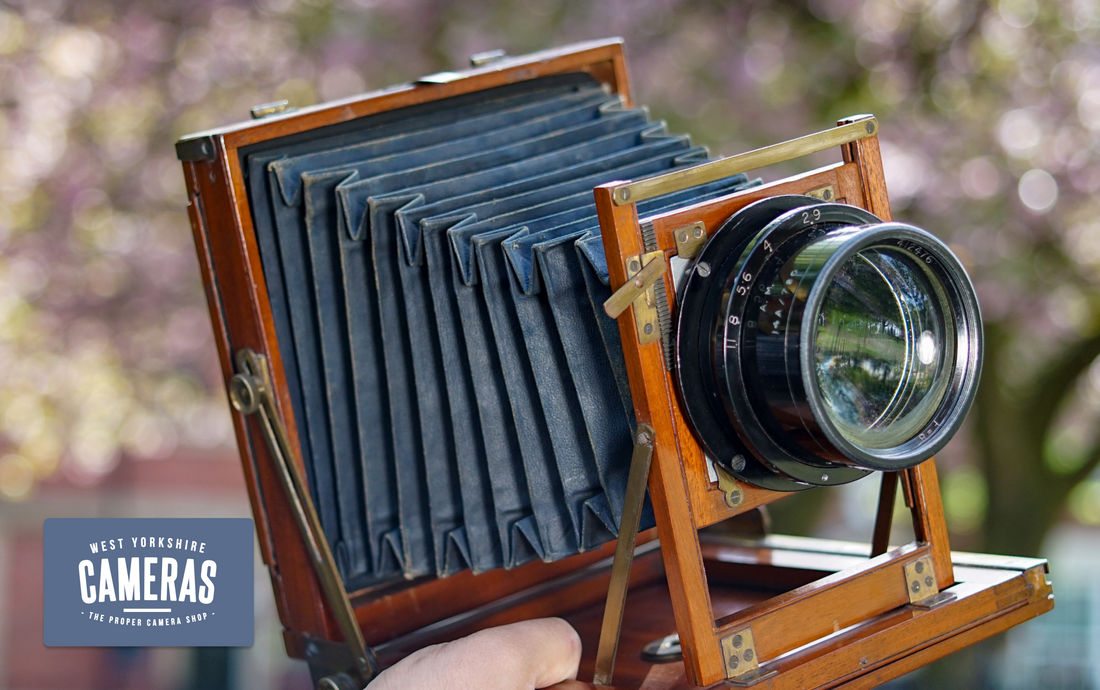By Ethan Delgado & Howard Parker
Adam's favourite item that has recently made it's way into our shop is this Adam's and Co. Half Plate camera from the early 20th century - with a large and fast 8" f/2.9 Dallmeyer Pentac lens.
Adam, being an Adam himself, was naturally drawn to a camera with his namesake. However, there are more reasons that make this camera an interesting choice.

YAY
This particular Adam & Co came to us fitted with the venerable Dallmeyer Pentac. It's not uncommon to see these unusual, oversized lenses hastily attached to a camera with copious amounts of electrical tape (certainly in Adam's experience) but here a previous owner has taken the time to make a lens board to mount the big lens properly. It sits snugly on the front standard. No light leaks, no wobbling.
This camera is all about that big chunk of fast glass.The Pentac was designed as a aerial recon lens. The barrel is crafted from lightweight aluminium, providing a notable weight reduction compared to brass lenses of similar speed. It's soft and pictorial look, achieved through a lack of coating and the use of five glass elements in a Heliar design.
Of course, it would be unfair to say the body itself is without charm. Lightweight and easily foldable, it is a versatile field camera which has survived well. The mahogany wood and brass fittings have worn into a lovely patina over the last 100 years.

NAY
It's not without drawbacks though. The same model field cameras of this era often came in various format sizes. This particular one is half-plate, which is slightly smaller than today's more commonly found 5x7 format. To use the camera requires some way of cutting down film or paper to fit the film holders - or buying difficult to find half-plate sheet film. Nevertheless, by adding a piece of glass or card behind it in the holder, this minor inconvenience can be easily overcome.
One rather...major disadvantage is that this camera lacks any form of shutter. This means very slow film or paper - and a tripod - are absolute requirements. Exposures must be made by physically blocking light from entering the lens with a hat or lens cap. If you want an analogue camera to slow you down...this might be the one.
Bellows (the expanding concertina bit in the middle) are often a problem on old cameras. After many years of opening and closing, they can start to exhibit wear at the corners and leak light, or just fall apart. New bellows have to be custom made, and are surprisingly expensive. Adam assures us that minor pinholes can be easily patched up with his signature black electrical tape, or book binding tape.

ADAM²
While these cameras may require some patience and practice, they are ultimately simple in design, consisting of a light-tight box with glass on one end and film on the other. The process of using them is slow and deliberate, requiring a measured approach.
Adam actually already has and often uses a very similar camera to the one here - albeit a larger whole-plate. Considering the size of the negative it produces, the relative portability of a field camera when collapsed and folded down, is a huge advantage.

For Adam, one of the main attractions to using a camera like this is that it lets you explore using old, relatively primitive lenses and the unique way they render images. They certainly add a distinctive touch to Adam's photographic endeavours.
Find more of Adam's work on his website or his Instagram


